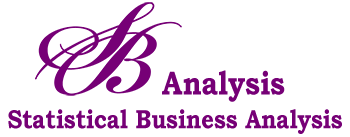Secrets to Making Business Decisions That Get Results
By far, the number one method to getting stellar results in business, is through the use of Applied Business Statistics.
- A grocery chain saved $900,000 by using the Lean Six Sigma statistical method.
- A company was getting poor results on its email marketing. Therefore, a statistical analysis was done resulting in an increase of 86 to 253% on all future ad campaigns.
You might be thinking: “Only the huge industry titans (Amazon, Google, Coca Cola, etc.) can afford to do statistical analysis of their data.”
The truth is… You can’t afford not to!!! If you want to keep up with your competition, or better yet, blow them away, you MUST analyze your data. Large corporations know that the only way to make sound business decisions, is with the insights that their data tells them.
Of the many advantages technology has introduced to business owners, few compare to the power of data. We can collect data from more sources than ever before, which, when used effectively, has a transformative impact on business operations as a whole.
There are several key ways that businesses are leveraging data sources to become more efficient and profitable than ever — let’s take a look at three big ones:
1. It Provides a Better Understanding of Customers
Regardless of whether you run an e-commerce store or sell B2B services, understanding your customers is key to your growth. Data can play a role in almost every facet of how you engage with your customers. As just one example, tracking results from website traffic and social media campaigns will reveal how your target audience is responding to your messages.
Data can also help you better understand your current customers so you can improve retention efforts. Data for a fast-casual restaurant, for example, might show a group of lunch customers who order several appetizers as their meal, or a group of dinner-goers who always order chocolate cake for dessert. Knowing these pieces of information, helps the firm make better customer segmentation decisions in order to better target offerings.
With solid data in hand, you can understand what does (or doesn’t) appeal to your target audience. You can adapt your marketing strategy or even sales training based on what you find.
2. It Identifies and Eliminates Supply Chain Inefficiencies
For businesses that sell a physical product, optimizing the supply chain can be a major challenge. There isn’t just the matter of keeping your manufacturing up to speed — logistics issues can show up when placing orders for needed supplies or shipping your products across the country.
As just one example, Supply Chain Dive reports that 40 percent of food waste in the United States is caused by supply chain issues, due to food spoilage that occurs while in transit. Damage to fragile items, or even shipping delays, can cause similar waste across many industries, which can hurt a company’s bottom line.
This is where data analytics can be powerful. By collecting key data variables, along with sound statistical analysis, businesses can identify and thwart potential problems. This can also help identify which suppliers are creating waste, thus helping a company avoid major losses.
As Amber Markim of Flash Global notes, supply chain data can also help companies track supply
and demand trends so they can optimize orders, manufacturing and responsiveness.
3. It Helps Businesses Make Faster, Smarter Decisions
By staying on top of your data, you don’t have to wait for months to find out if a change to your supply chain is having the desired effect.
The first step in the decision-making process is to determine the precise questions you are trying to answer. This will help to streamline the data collection process and avoid wasting resources.
This means collecting data from the right sources and focusing on key performance indicators that are relevant to the questions you are asking. While data analytical tools can present a lot of numbers, knowing how to interpret the results is what sets some firms apart – these are the ones that are leading the pack.
With quality data on your side, you will have greater confidence when making business decisions, while also becoming more agile. In fact, a PwC survey of 1,000 business executives found that data-driven organizations were three times as likely to achieve major improvements in their decision-making capabilities.
When your decisions are backed by solid data analysis, you won’t just rely on gut instinct or guesswork. You can take proactive steps based on known information, using patterns and trends to make key changes to improve your output — and your bottom line.
Use Data for Smarter Business Planning
Your data can have a profound impact on almost every area of your business. Of course, your data will only be useful if you are able to interpret what the numbers mean for your brand, and you are willing to act on those insights. When you learn to trust your data and act decisively, you will gain a distinct competitive advantage that translates into measurable results.
The following are two examples of how we have used Applied Business
Statistics and Lean Six Sigma tools for smart business decisions.
Case Study 1: An auto parts manufacturer had a piece of equipment with an average lifetime of 12 years. The piece of equipment was in its 7th year, and for capital budgeting purposes the firm wanted to determine the following probabilities:
a. The likelihood that the equipment would last more than 12 years.
b. The likelihood that the equipment would last less than 12 years.
c. The likelihood that the equipment would last between 9 and 11 years.
The firm used various statistical analysis techniques and determined the following:
a. The likelihood that the equipment would last more than 12 years = 36.79%
b. The likelihood that the equipment would last less than 12 years = 63.21%
c. The likelihood that the equipment would last between 9 and 11 years = 7.25%
With these results, the firm now has solid data to make a decision that is much more likely to result in success.
Case Study 2: A well-known Fortune 500 company provides on-site service as one of its main products. The company surveyed customers that were serviced within the last six weeks. The main question asked: “How was your overall service experience?” The random survey of 100 customers rated their service experience at 76.1% Satisfied.
The firm then implemented the Lean Six Sigma (LSS) Improvement Process, to develop and implement effective solutions. For the next twenty random customers surveyed, this service department achieved an overall satisfaction rating of 100%

